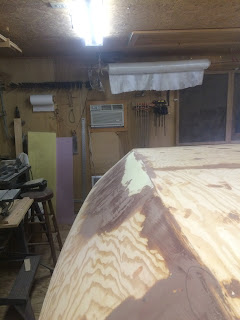I had to take a deep breath after the fiasco with the bottom. It gave me a lot of comfort to know that the bottom was not only very very sturdy after all that matting and filling, but I got the shape I wanted. The pictures never really show mistakes all that well, but even here the 1 inch plus gap under the batten strip would show up.
So after picking all of the fiberglass bits from my hair, mouth and clothes, and breathing a nice sigh of satisfaction I turned my attention to the new issue. The bilge panels.Papa sent me to get a sheet of 3/4 inch extruded polystyrene from the lumber yard. There will be some custom shaping to get the lines right. I decided to roll the dice and go to Two Harbors Lumber to see if they had some on hand. Gene has been running the lumber yard for at least a hundred years and the inventory can be a crapshoot. He and his mom run everything in true small town fashion. I recall buying a pair of boots there years ago and had forgotten my wallet. Gene's mom wrote me out an honest to God IOU and pinned it on their bulletin board. That's not something I'd expect anywhere, but it made my heart swell a bit and of course I came back with a check later that afternoon.
On this day I showed up and Gene rummaged around in one of his half empty tin buildings and found a few sheets of 3/4." He kind of scratched his head and asked why I only needed one sheet. When I told him it was for a boat I'm building he didn't ask any other questions about it, but commented "you could just dig a hole and throw money in it too..." I laughed nervously, thinking of how much I'd already spent and knowing my current materials would only net me a semi-finished hull. I don't remember what he charged me, but it was surprisingly low for Gene's standards and I'm guessing he must have felt something like pity for me. If only he knew that I would be swimming in foam dust for days.
The basic idea was to outline some low areas using the batten strips on the curved surfaces of the bilge panels and a straight edge on the sides of the hull. Then glue on a panel of foam and sand it and feather it until the hull is fair in all directions. The pictures don't really show the issues and sometimes, due to optical delusions, the lines look crazy when they are finally quite fair.

 Once the foam was about right, I mixed up some filler, made a mess and then sanded most of it off. It reminded me of hanging drywall, but using really expensive, hard to sand, mud.
Once the foam was about right, I mixed up some filler, made a mess and then sanded most of it off. It reminded me of hanging drywall, but using really expensive, hard to sand, mud.Anyways, you get the idea. When I asked Papa how strong the foam would be. He showed me a set of plans for a trimaran and pointed out that the outriggers were constructed entirely of foam and fiberglass. He said in his experience, you could take a hammer to the hull and the fiberglass would determine the durability, not the foam.
Speaking of fiberglass...There happens to be a giant roll of it hanging from the ceiling in most of my pictures. Well it's finally going to get it's day. And durability? Yeah I'll be doing two layers with wide overlaps and forgoing the taped seams.



No comments:
Post a Comment